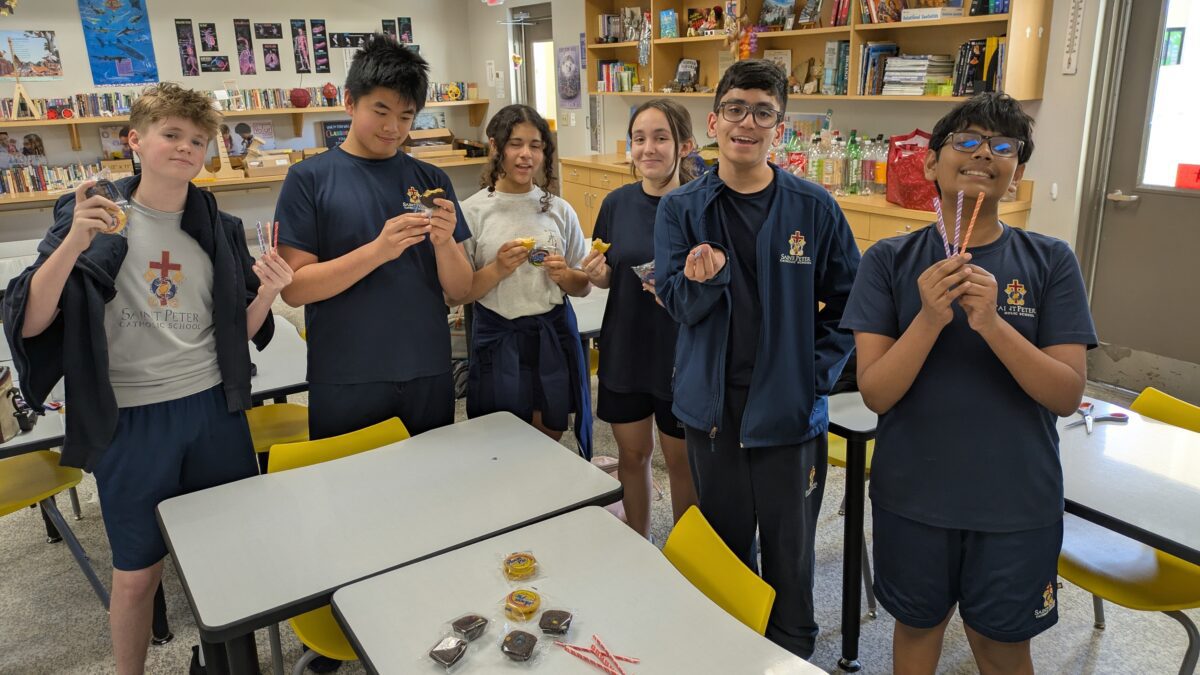DELAND | Several months ago Embry Riddle Aeronautical University approached Donna Wilkins, a teacher at St. Peter School in where she is also STEM Club director, about applying for a grant to “Build the Moon.”
The school won the grant and with little more than a month to accomplish the task, St. Peter students completed the challenge and garnered recognition.
The team of seven middle schoolers from St. Peter earned top honors in the national Build the Moon Challenge, sponsored by the California-based Institute of Competition Sciences. Competing against students from eight states, St. Peter’s team impressed judges with their innovation, research and creativity, ultimately securing the best in show award.
The competition challenged middle and high school students to take on a lunar engineering feat — designing and testing materials that could one day be used to build infrastructure on the moon. The project centered around a simulated lunar regolith — the layer of loose, unconsolidated material, including rocks, soil, and dust, that covers the surface of solid rock, like the earth, moon or other planets. The regolith was developed in Central Florida and teams could modify it using additives, so long as the final mixture remained under a 50/50 ratio. Wilkins said their distinctive additive as sawdust.
“The students worked diligently to create material suitable for use in multiple lunar applications, including a landing pad, a brick wall, and even a 3D piped structure,” Wilkins said. “Their custom recipes were tested in a battery of scientific experiments, assessing density, solubility, weight-bearing capabilities, drop resistance, wettability, and chemical reactivity with soap and alcohol.”
But this project wasn’t just about physical materials, she assured. The team also had to design a lunar habitat. Eighth-grader Sophia C. said that was her favorite part. She used OnShape, a computer-aided design (CAD) software to illustrate it. The habitat had to support a crew of four for six months, offering safe entry and exit, life support systems, laboratory space, and protection from harsh space radiation.
“I wanted to be a part of this project because I am very interested in STEM related subjects. The fact that our STEM Club got the chance to do this made me think it was a good idea not to turn it down. It was a good commitment,” Sophia said.
“Everyone had a role in (the lunar habitat). Some researched what we had to put into the habitat. I got the chance to draw it out and later make a CAD model for it,” she explained.
“I learned how much effort it takes putting people into space – especially when we had to decide what materials and how we were going to design our habitat. The topic of what materials realistically could go onto the moon with a realistic budget, since it costs so much to put things into space… that shocked me — how much of an effort it takes to get even simple items into the moon,” she said.
Sophia said she’s always been very interested in aeronautical engineering, but as of late finds she is drawn to the more artistic aspects. Now she is considering fields like biomedical engineering which involve drawing diagrams and anatomy.
Students conducted extensive research into feasible additives and design shapes, using knowledge of the moon’s environment and in situation resources to reduce the need to transport materials from Earth. Their final hexagonal habitat design was backed by thorough justifications and detailed documentation, including written narratives, PowerPoint presentations, photos, and video submissions.
To show how piping could be applied to the lunar habitat, eight-grader Francisco L. explained, “We did pipe over an inflated structure to show how the piping could be applied to the habitat structure using a glove. One of the fingers of the glove simulated one of the airlock units connecting to another part of the village.”
Francisco wanted to participate in the project thinking it “would be a fun, new experience.” Already considering studying engineering, he said he enjoyed the construction aspect. He found the “time constraint” most challenging. “Everything had to be done in a month. If something were to go wrong, we would have very little time or no time at all to fix it,” he said.
The culminating moment for Jeyron J. was “when we got to see the results of our version of the regolith and started to test it,” he said. “Everybody got to do at least one test. We also got the feeling that, yeah, we didn’t mess it up. The final regolith recipe that worked included little pieces of sawdust, corn starch and plaster of Paris. Those materials, in the end, gave us the sturdiest structure.”
“Despite the challenge of meeting only once a week through our school’s STEM Club, the students made every moment count — often putting in extra hours to bring their vision to life,” Wilkins said. “I’m incredibly proud of what the students accomplished. Their curiosity, problem-solving skills, and teamwork were on full display. As the dust settles on this year’s competition, these students are already looking ahead — perhaps to Mars next?” she quipped.
By Glenda Meekins of the Florida Catholic Staff, May 08, 2025

